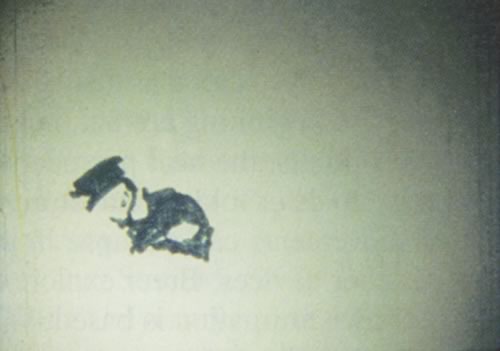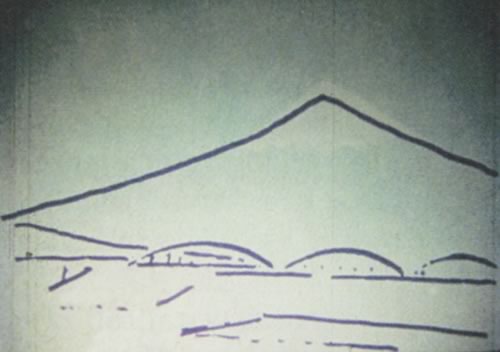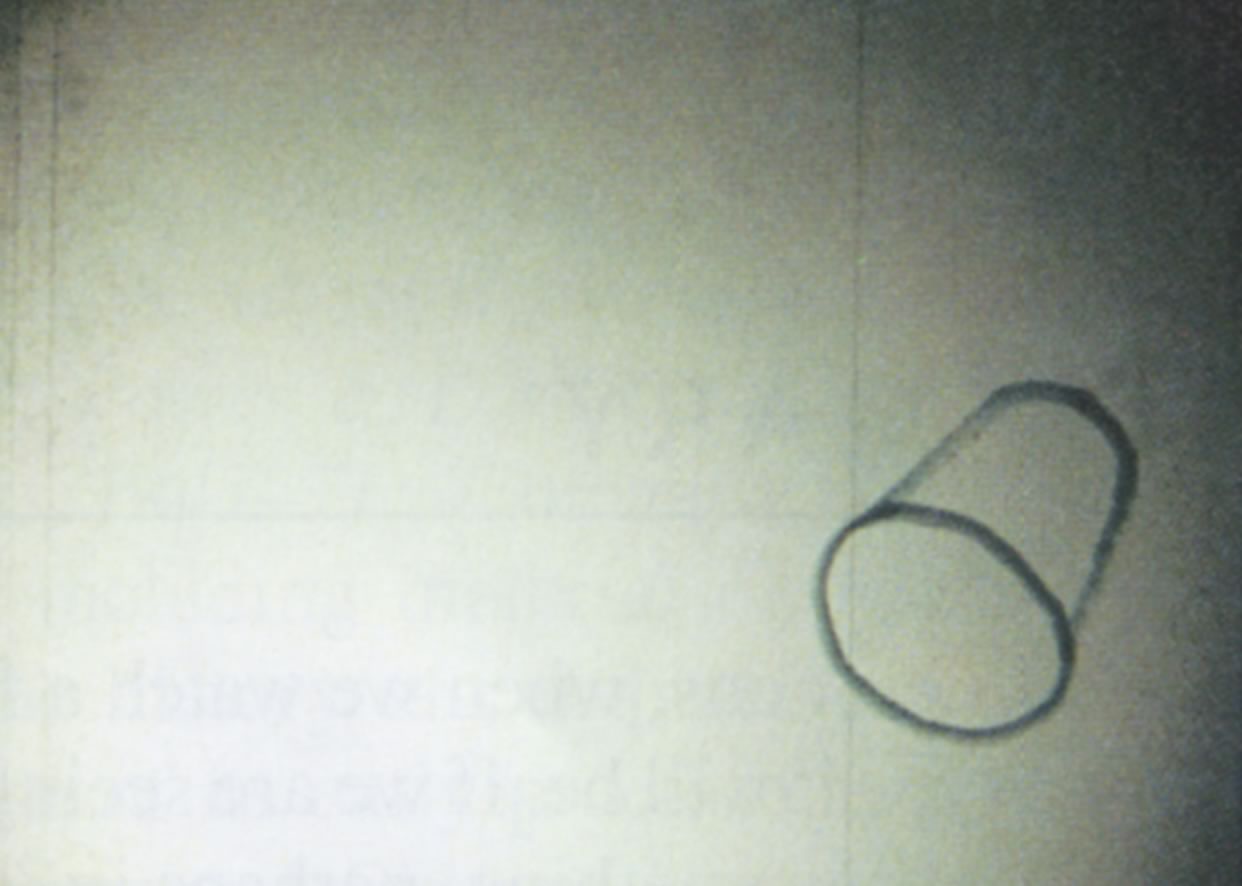An Example of Experimental Animation: Fuji
excerpt from Film Art: An Introduction, 9th edition, McGraw-Hill (2010): 388-390.
In contrast to smooth Hollywood narrative animation, Robert Breer’s 1974 film Fuji looks disjointed and crudely drawn. It doesn’t involve a narrative but instead, like Ballet mécanique, develops according to principles of abstract form.
Fuji begins without a title or credits, as a bell rings three times over blackness. A cut leads not to animated footage but to a shaky, fuzzy shot through a train window, with someone’s face and eyeglasses partially visible at the side in the extreme foreground. In the distance, what might be rice paddies slide by. This shot and most of the rest of the film are accompanied by the clacking, rhythmic sound of a train. More black leader creates a transition to a very different image. Against a white background, two flat shapes, like keystones with rounded corners, alternate frame by frame, one red, the other green. The effect is a rapid flicker as the two colored shapes drift about the frame in a seemingly random pattern. Another stretch of black introduces a brief, fuzzy shot of a man in a dark suit running across the shot in a strange corridor.
More black leader follows. Then, against a white background, a jagged line moves and changes shape, briefly coming together to form a crude tracing of the running man’s movement, then collapsing quickly into an abstract line and reforming into a running man. During this shot, colors shift and change rapidly.
Within this spurt of images, Breer has aroused our curiosity about what kind of film we are watching. He has also introduced most of the motifs that will be varied across the film to create its principles of abstract form. For one thing, the regular clack and hum of the train sets up a rhythm that will govern the movement on the screen. A flicker effect in which images change everyone or two frames will recur through much of the film. Even when the same shape remains on the screen for a longer stretch, its color and outline often jitter in a rough rhythm.
Such attempts to avoid smooth movement and to explore the possibilities offered by different types of abstract drawings are common in experimental animation. Fuji is distinctive, however, in part because of its juxtaposition of live-action footage and animated images that are obviously sketchily traced from the live-action frames. Here Breer is manipulating a technique commonly used in Hollywood cartoons (and, more recently, Japanese anime): rotoscoping. The rotoscope is a machine used to project live-action footage, frame by frame, onto a drawing board, so that an animator can trace the outlines of the figures. The original purpose of rotoscoping was not to make the characters in the cartoon look exactly like those in the live-action film, for in fact their appearances are often quite different. Rather, a character’s movement is usually smoother and more lifelike if traced from a live model. Disney’s animated features, such as Snow White and the Seven Dwarfs and Cinderella, used extensive rotoscoping for their human characters. (Computer animation works with a similar principle but uses three-dimensional tracing and mapping.)
Breer takes rotoscoping, a technique intended to create smooth motion, and uses it in quite a different way. For one thing, he often traces only part of a figure, leaving it against a blank white background instead of tracing it onto a cel and combining it with painted scenery. In other cases, he traces the background itself rather than the moving figures, as with the train interior that appears in various colors. He also photographs his rough pencil drawings, rather than tracing them neatly onto cels in ink, as a Hollywood animator would do. By changing the color so often and by moving from image to image so quickly, Breer’s animation avoids all sense of smoothness. (Breer uses blank index cards for his drawings, deliberately avoiding the illusion of depth that cel animation can achieve.)
Most of the flickering images in Fuji are two frames long, and here Breer may be playing off the fact that in Hollywood cartoons of the studio era, each set of cels was actually photographed for two frames in a row, to save time and labor. In the Hollywood films, the movement still appears smooth and continuous on the screen, while Breer creates such noticeable differences between each pair of frames that the effect looks jerky.
Perhaps most daringly, Breer includes bits of the original live-action footage from which he made his tracings. As a result, we are led to see many of the images in the film as tracings (10.109, 10.110). In effect, Breer has taken one of the most realistic animation techniques, the rotoscope, and used it to create a dazzling, abstract exploration of movement and perception in cinema.

Figure 10.109: Early in Fuji, we see flickering images that include single frames of blurry live-action footage of the train’s interior…

Figure 10.110: …alternating with single
frames of parts of that same view in crude
tracings of the conductor’s body.
The opening section of Fuji is based chiefly on shapes derived from train interiors. The second, lengthier section, which forms the rest of the film, begins with a stylized series of views of a mountain that we assume from the title is Mount Fuji. Again we see shifting colors and shapes, but as before, some of the footage seems to have been traced from live-action frames. The train sound continues, and as sparsely sketched buildings, bridges, poles, and fields move jerkily past in the foreground, we are likely to take this view to be one seen from a moving train-though in this case Breer does not alternate live-action and traced footages (10.111).

Figure 10.111: A simply sketched view of a mountain and passing bridge in Fuji.
“What attracted me to the footage was the mountain in the background and the possibility for motion perspective in the foreground. The film plays with deep space and the picture plane on the screen.”
—Robert Breer, animator
The mountain footage creates planes in depth: fields and buildings in the middle ground pass by, while the distant mountain remains in the same spot. At times colors or abstract shapes appear for a frame or two, and we are likely to perceive them as being in the extreme foreground, near the train and thus visible only as a blurred flash. Yet, even though the mountain remains in the same spot, its simple black outline frequently shifts slightly, and the color changes constantly, making the sky now red, now blue. The smooth sense of motion that rotoscoped footage could create is undermined, and the stable mountain actually shimmers constantly. In this way, Breer simultaneously suggests realistic depth and flat, abstract shapes in the images.
To underline this contrast between conventional animation and the abstract techniques of Fuji, Breer includes one ordinary rotoscoped motion (10.112). This paper cup shape, drawn with the simplest of perspective cues, is the only object in the film to move so smoothly. We also, however, see the cup changing color or superimposed over the more abstract, flickering images of the mountain. At other times, the cup shape is seen as just a flat blob of color. Indeed, the rounded keystone shapes near the beginning are flat, nonperspectival versions of this cup.

Figure 10.112: Fuji’s most conventional
animation: a paper-cup shape rolling
in an arc against a white background.
At other points, the neat perspective renderings of the cup suddenly twist into skewed trapezoids or fold up into straight lines. Thus even the most conventional of animated movements can collapse in this pulsating, unstable space. With this and dozens of other devices, Breer explores and displays many of the perceptual tricks on which drawn animation is based. While Duck Amuck flaunts the unique powers of animation in order to create comedy and deflate our narrative expectations, Fuji, an experimental film, takes animation techniques as its very subject. The result is a film that asks the viewer to enjoy its abstract design and reflect as well on the possibilities of animated filmmaking.
|



